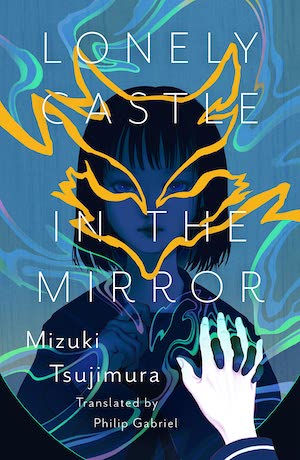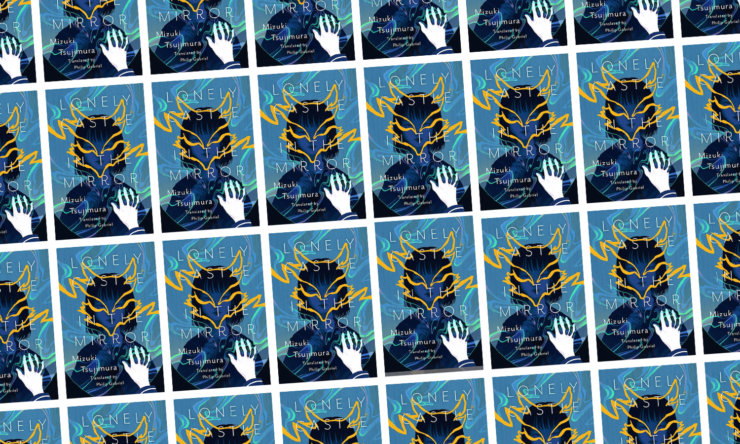The easy and well-adjusted adult thing to say is that Lonely Castle in the Mirror is the book I needed when I was a teenager—an astoundingly earnest and often awkward, painful journey into the heart of lonely kids who didn’t fit in. But it wasn’t. When my body was still working its way through puberty and preparing to unleash an onslaught of acne and on my self-esteem, what I wanted was pure uncut escapism—lurid teen thrillers, dramatic coming-of-age stories far from my reality where I could project myself into another world, and I often ended up reading things a little “too old” for my age group, like my dad’s collection of Stephen King books and my mom’s copy of Elvis and Me by Priscilla Presley (without a doubt, definitely not for kids).
Mizuki Tsujimura’s novel—translated from Japanese by Philip Gabriel—for all its “classification” as a YA book, is a moving psychological journey for adults who have tried, as hard as they can, to forget the most perplexing and emotionally turbulent stage of human life. We meet shy 7th grader Kokoro in an exceptionally rough patch—it’s her first year of junior high, and her enormous public school is fertile ground for bullies to find fresh meat. After a traumatizing incident with a popular clique, Kokoro refuses to go to school, and her parents aren’t sure what to do. Slowly unfolding the particulars of her situation triggers an instantly identifiable sense of empathy, though it’s curious to realize that my initial reactions to Kokoro’s plight—one that any awkward kid might be familiar with—are tainted with age and hindsight; it takes time for me to warm up to the book, perhaps because it echoes such similar things from my own youth that I’d rather leave half-remembered.
One day, the now-borderline agoraphobic Kokoro notices her bedroom mirror emitting an unearthly bright light. She’s pulled into a mysterious fairytale-like castle—an enormous place that I imagine is a dead ringer for Neuschwanstein. There are six other kids there, each loosely following a different Breakfast Club-like stereotype: the jock, the cool girl, the nerd, the edgy loner, and so on—and a cryptic, often caustic little girl in a wolf mask, who tells them they have one school year to find a hidden key to a place called the Wishing Room. Whoever finds the key can make a wish that will come true. And just like that, the Wolf Queen leaves them to it.
Buy the Book


Lonely Castle in the Mirror
What follows is one part after-school club dysfunction, one part informal group therapy, and a fictional case study of the young teen psyche in the social pressure cooker of Japan’s public school system. I’m not going to pretend like I know anything about the finer social and cultural points of the book’s Japanese context, but I do know that all teenagers can be cruel and callous and exceptionally spiteful when they want to be. This is a universal fact. Most of us have played both roles, as bringers and receivers of pain, though it often takes time (and hopefully therapy, or some good friends) to realize it.
As the kids slowly, warily start to get to know each other over the course of the year, it becomes crystal clear that the whole “why are we in this castle” thing would have been greatly expedited if they had been open and honest with each other from the start. But this is a story about layers—an onion of progress through pain—and it begins with them cautiously observing each other, adjusting to each other, throwing careful stones in the conversational pond to see how deep it goes. They’re free to come and go from the castle during its “open hours”—a rather bizarre formality that mirrors school hours. All the kids seem like paragons of dysfunction hovering just outside the academic system—each is either on a self-imposed hiatus from school, attending juku (which we might know as after-school tutoring programs), or simply just not a normal, functioning student. And while everyone is thinking about finding the key, no one is willing to just come out and admit how much they want that wish, even if it means consequences for the whole group.
From all of this, one might wonder what they’ve done to earn their status as school pariahs. And the answer is: nothing. As much as the book leans into the “delinquent” framing to draw you into a deeper exploration of compassion and empathy in one of the most psychologically (and for some, physically) vulnerable stages of life—growing up and learning about conformity the hard way—Kokoro and her friends don’t suffer from anything extraordinarily weird or freakish. They’re everyday products of their own pockets of reality—some are from struggling working-class backgrounds with broken families, while others are barely holding up to the pressure and expectations heaped upon them by parents and teachers. Here, Tsujimura gets relentless with her portraits of bickering parents, the way kids internalize what they hear, the innate desire to please, and the little lies we tell to make ourselves seem more appealing to the people around us.
Lonely Castle in the Mirror is ultimately a book about the deeply convoluted ways that parents try and “manage” their children, especially in the context of a modern capitalistic society that imbues time with productive, formal meanings. Kokoro’s time is precious—she can only go to the castle between 9am and 5pm, which is usually reserved for socially appropriate commitments like school and work. Her schedule, her parents’ schedule, the school schedule, and the castle’s schedule are all relentless reminders of the way we’ve carved out time to serve what capital values: jobs, diplomas, and automatic respect and understanding from her peers. When she ventures outside her house, her panic is palpable—she can’t be seen, because she simply doesn’t belong out in the world like some kind of truant delinquent.
I found the book marketing slightly frustrating as it described itself as Murakami meets Eugenides’ The Virgin Suicides (note: translator Philip Gabriel works frequently with Murakami). This, of course, is marketing shorthand to explain that this is a Japanese book that leans on magical realism and a frank discussion of teen depression. Murakami, for all he did for me as in my twenties when I needed him, has a rather distant, dry voice. Tsujimura, on the other hand, is unabashedly sincere, almost to the point where her observations might feel too blazingly honest for an adult withered by years of cynicism and indifference. But it’s almost perfect for Kokoro as a precocious teen narrator. The Virgin Suicides, too, is a rather misleading comparison as it focused on external observations of a group of highly objectified girls, and lacks the barefaced emotion that Tsujimura expertly weaponizes through Kokoro.
For all its brutal examinations of the inner lives of Kokoro and her group, and the very moving evolution of their friendship, the story wraps up a little too nice-and-neatly for someone expecting an edgy finale. This isn’t to say YA is inherently straightforward as a genre, but it probably says more about me as a reader that I went into it expecting a much more ambiguous resolution. It’s bittersweet—you can’t have your cake and eat it too, but in this world, Tsujimura does as much as she can to make you believe that there will be more cake tomorrow. Lonely Castle does best when it hints at things beyond Kokoro’s ken—boys, dating, whatever it is that popular girls do outside of school. Tsujimura is a master at projecting these young anxieties onto the page, offering hints and shadows and silhouettes of what the world might be like once we finally grow up, and how difficult it is to take that first step.
Lonely Castle in the Mirror is published by Erewhon Books.
Alexis Ong is a freelance culture journalist with weak ankles who mainly writes about games, tech, and pop culture. Her work has appeared in The Verge, Polygon, Kotaku, Rock Paper Shotgun, VICE, Dazed Digital, and more; soft spots include science fiction, internet archaeology, comics, boxing, and old games. You can find her at her website or on Twitter.










